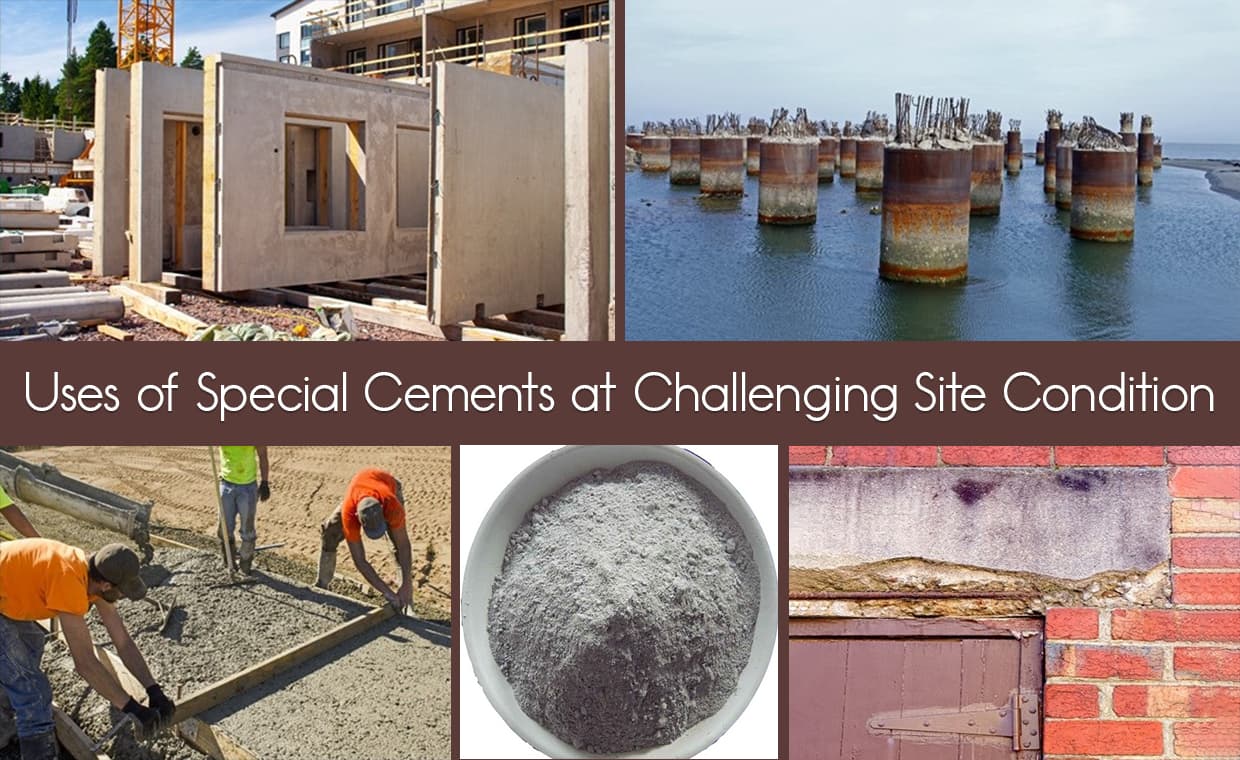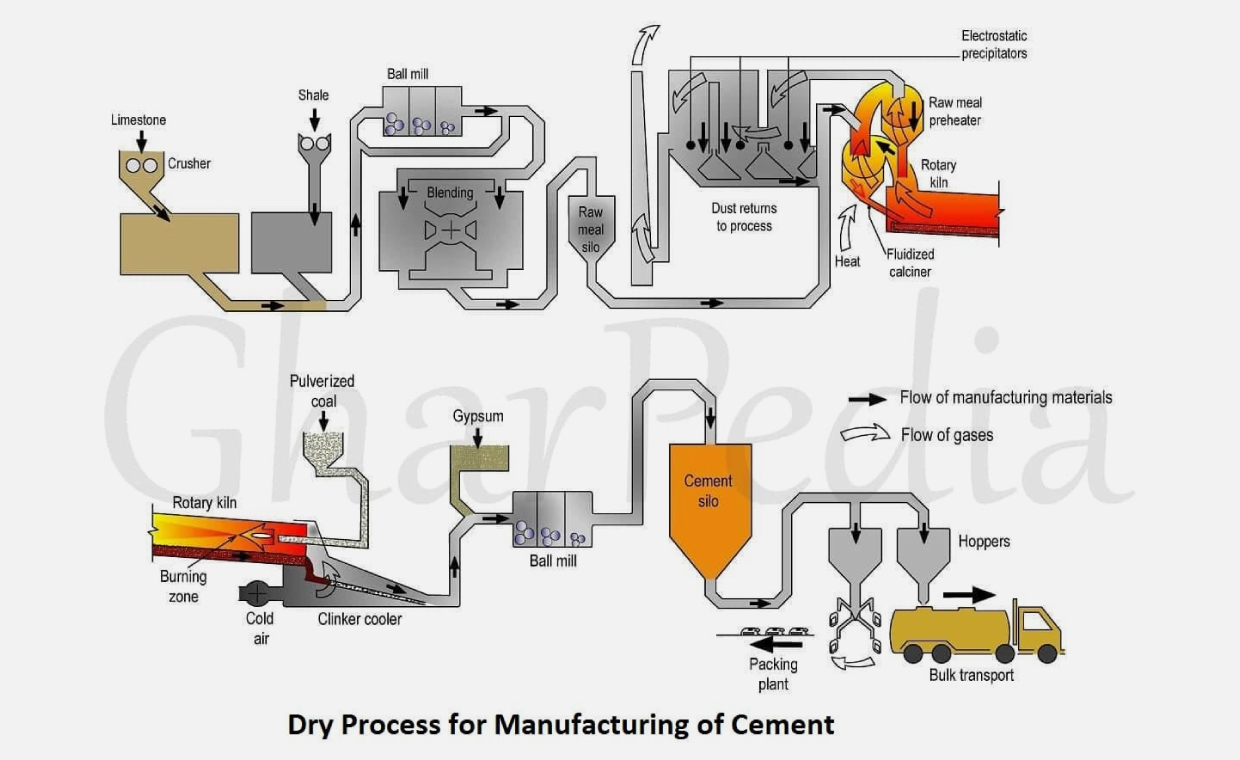
Why Special Cement?

During construction you might come across various types of problem. Say for instance- you might have to do concreting in water or you can have an emergency where you want to remove formwork immediately or your site is located in a saline area subjected to sulphate attack etc. In such cases using ordinary Portland cement or PPC will not help you much, as it will not unravel your critical exigent problems or allow you to carry on your work efficiently and effortlessly on the site. Thus, such distinctive site conditions necessitate the uses of special cements meant for special purposes.

There are various types of special cements available for concrete construction. Each type of special cement has some specific functional objectives in terms of application, performance and durability because of its specific properties.
Here’s Gharpedia trying to provide you with solutions by suggesting you the uses of special cements for different challenging site conditions.
Types of Cement
01. Sulphate Resisting Portland Cement
Composition
In this cement, percentage of tricalcium aluminates is kept below 5-6 per cent, thereby resulting into increased resistance against sulphate.
Challenging Site Condition/Specific Work/ Circumstances/Situations/Problems
The concrete structures which are continuously exposed to high concentration of sulphates such as
- The homes/ buildings which are situated near seashore or beach; or similar structures located very near to coastal area where the groundwater is saline, the soil is likely to have salinity with sulphates more than permissible limits
- Sewage and water treatment plants
- In case where you need to protect your foundation from corrosion on account of sulphates
- Pile foundations
- Food processing industries, petrochemical plants, basements & underground structures, fertilizers & sugar factories, concrete sewers carrying industrial wastes etc.
How Does it Help?
To withstand sulphate attacks and to prevent corrosion in concrete structures in future. This cement is used to build structures which are prone to damage by sever alkaline condition like culverts, canal linings, siphons etc.Gharpedia has also written an article on how to repair corrosion damaged concrete. Do have a look.
02. High Alumina Cement
Composition
This cement is made by grinding lime and bauxite clinkers formed by calcinating. The overall volume will not be less than 32 per cent and the alumina to lime weight ratio should be between 0.85 and 1.30.
Challenging Site Condition/Specific Work/ Circumstances/Situations/Problems
The concrete structures which are exposed to high temperatures like
- Fireplace in your home, Refractory lining, furnaces, Interiors of kilns, workshops, Funeral homes, Restaurant’s kitchen etc.
- The concrete structures exposed to dilute solutions of acids such as refineries.
How Does it Help?
To resist abrasion, thermal shocks and acid attacks. Its Initial setting time is about 31/2 hours therefore, allows more time for mixing and placing operations. It can withstand high temperatures. It generates a huge amount of heat during setting hence it is not affected by frost action. It resists the action of acids in a better way. It attains higher ultimate strength.
03. Quick Setting Portland Cement
Composition
This cement is prepared by adding a small percentage of aluminum sulphate which reduces the percentage of gypsum. The gypsum retards setting action. Adding aluminum sulphate accelerates the setting action of cement.
Challenging Site Condition/Specific Work/ Circumstances/Situations/Problems
The concrete structures raised on or nearby water bodies, or In rainy and cold regions such as:
- If you want to build your home on the water bodies such as lake, river or water logged area, or area where water is flowing or where ground water table is high (sites near river, lakes etc).
How Does it Help?
The Initial setting time of this type of cement is about 5 minutes. It is therefore used where concrete needs to set quickly.If you are inquisitive in knowing what is setting time of the cement, please click on the article below.
04. Expansive Cement
Composition
According to ‘A. M. Neville’ (Author of Concrete Technology), this cement consists of a mixture of Portland cement, expanding agent and stabilizer. The expanding agent is obtained by burning a mixture of gypsum, bauxite and chalk which form calcium sulphate and calcium aluminates. Hence, this cement expands while other cement shrinks.
Challenging Site Condition/Specific Work/ Circumstances/Situations/Problems
Liquid storage tanks, hydraulic structures, water repair works (to create a bond with the old concrete surface), bridge decks, pavement slabs, in hot weather conditions, construction of water retaining structures and also for repairing the damaged concrete surfaces.
How Does it Help?
It has self-stressing and shrinkage compensating properties which reduce cracks thereby controlling leaking/dampness later on.There are two methods of manufacturing the cement. To know in detail, you may click on the articles below.
05. White Cement
Composition
This is a type of ordinary cement and it is manufactured from raw materials which are practically free from colouring oxides of Iron, chromium or manganese.
Challenging Site Condition/Specific Work/ Circumstances/Situations/Problems
To fill joints in flooring (Marble flooring, Ceramic tile flooring, Vitrified tile flooring, Porcelain tile flooring etc.) & plumbing, precast ornamental concrete products, interior and exterior decorations etc.
How Does it Help?
To enhance the architectural & aesthetical view.
06. Coloured Cement
Composition
Cement of several colours can be obtained by mixing mineral pigments with ordinary cement. The proportion of colouring can vary from 5 to 10 % percent.
Challenging Site Condition/Specific Work/ Circumstances/Situations/Problems
For adding aesthetic value, Artificial Marble, Floor finishing
How Does it Help?
Chromium oxide imparts red, brown or yellow colour for different proportions.
07. Hydrophobic Cement
Composition
This type of cement contains admixtures which diminish the ability of cement grains to wet. Acidolnapthene soap, oxidized petrolatum etc. are the common hydrophobic admixtures.
Challenging Site Condition/Specific Work/ Circumstances/Situations/Problems
In wet climatic conditions.
How Does it Help?
It is used to impart water repelling properties. By using hydrophobic cement, the fine pores in the concrete are distributed evenly, thereby considerably increasing the frost resistance and the water resistance of such concrete.
08. Masonry Cement
Composition
This cement consists of a mixture of ground limestone and Portland cement or other filler together with a water-repellent additive or an air-entraining agent.
Challenging Site Condition/Specific Work/ Circumstances/Situations/Problems
Masonry constructions
How Does it Help?
It has a greater water retaining property that results in a lower shrinkage and therefore there is a less possibility of cracking.
09. Portland Pozzolana Cement
Composition
This cement is produced by adding pozzolanic materials like shales, fly ash, clays etc.
Challenging Site Condition/Specific Work/ Circumstances/Situations/Problems
Where early strength is required with age
- Water tightness
How Does it Help?
Alike rapid hardening cement, this cement also gains high compressive strength with age. It is economical as well as affordable.
10. Low Heat Portland Cement
Composition
It contains lower percentage of tricalcium aluminates (C3A) and higher percentage of dicalcium silicate (C2S).
Challenging Site Condition/Specific Work/ Circumstances/Situations/Problems
The concrete structures where mass concreting is required such as
- In case of skyscrapers, or high large size apartments/ buildings, particularly in poor soil where you may need to do raft foundation with a thick slab.
- gravity dams, spillway sections, stilling Basins, Marine structures, large foundations, large rafts, thick pavements etc.
How Does it Help?
The mass concrete continually generate heat because of the chemical reactions which may lead to shrinkage cracks later on. This type of cement is used to control the rate of heat generation in mass concreting to prevent thermal and shrinkage cracks.
11. Air Entraining Portland Cement
Composition
AEC produced by mixing small amount of air entraining agent
Challenging Site Condition/Specific Work/ Circumstances/Situations/Problems
The concrete structures subjected to frost actions.
How Does it Help?
It acts as a resistant to severe freezing & thawing actions and simultaneously dilutes the effects of applications of salt for snow and ice removal.
12. Oil Well Cement
Composition
According to ‘IS : 8229 – 1986’ Oil-well cement of classes A, B, C, D, E, F, C and H, are manufactured by grinding clinker consisting essentially of hydraulic calcium silicates. No material other than one or more forms of calcium sulphate is inter-ground with the clinker or blended with the ground clinker during manufacture of the cement.
Challenging Site Condition/Specific Work/ Circumstances/Situations/Problems
Petroleum industries for gas, drilling of oil wells, etc.
How Does it Help?
It holds out against extreme conditions of temperature and pressure.
13. Rapid Hardening Portland Cement
Composition
This cement is produced by mixing finely grounded lime stone and shale at high temperature.
Challenging Site Condition/Specific Work/ Circumstances/Situations/Problems
The concrete structures such as
- Road pavement (thickness of pavement less than 150 mm) nearby your home or when you want road to open for traffic immediately)
- Precast concrete casting
- Repairing works etc.
How Does it Help?
It helps in achieving high strength in initial stages for structure subjected to early load (For example to open road for traffic immediately) or to reuse formwork again, so as to save on cost of formwork by multiple use. It is not damaged easily. This cement requires short period of curing.
14. Blast Furnace Cement
Composition
For manufacturing this type of cement, slag is used. This slag is obtained from a blast furnace during the manufacture of pig iron, and it contains basic elements of cement, like silica, lime and alumina.
Challenging Site Condition/Specific Work/ Circumstances/Situations/Problems
Seawater construction
How Does it Help?
This cement has almost the same properties as ordinary cement. It is low-priced because slag is used in the manufacturing of this cement which is the waste product.
Conclusion
From the above content you can see that there is a wide range of special cements in the construction industry, each type serving an explicit purpose in terms of performance, durability and applications to cope with the challenges faced at site. While each may be used based on a particular design requirement, others may be combined with certain standard or special types to accomplish some special aesthetic as well as functional objectives.
Must Read:




































